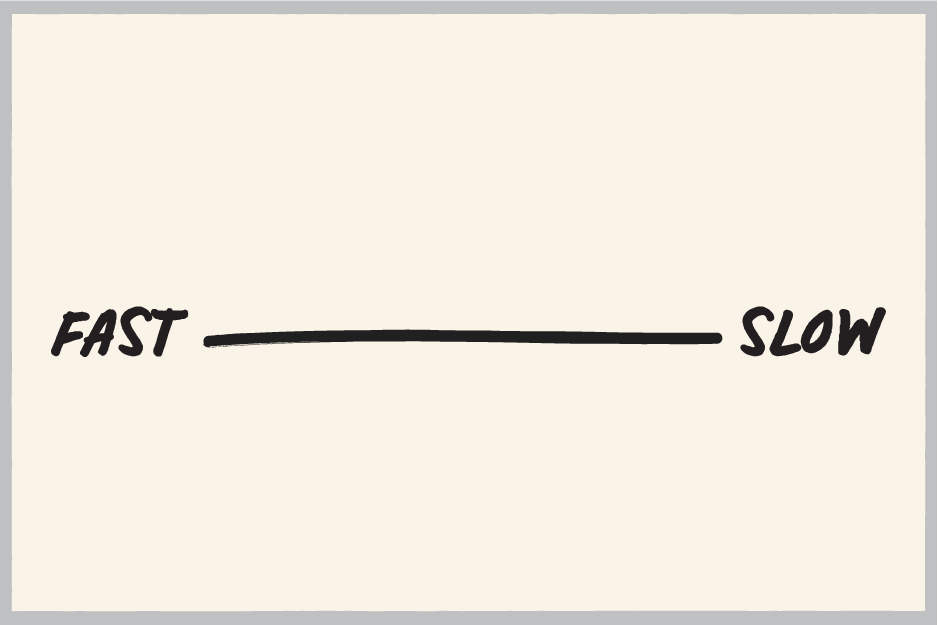
There are many factors to consider as you set out to build or strengthen your company’s employment brand, including the type of branding content you desire and the tone of your internal messaging. You'll also need to resolve one critical component of internal communications: How quickly your company’s brand should communicate.
Imagine this: In one of your conference rooms, there’s a long, horizontal line drawn on a whiteboard. On the left side is the word “fast.” On the right, “slow.” Now imagine representatives from HR, Marketing, Operations and Internal Comms are all sitting in that room.

If you were to ask how your company is communicating with employees today, where on the line would you expect the attendees to draw dots? If you then asked how your company should communicate with employees, what would you expect to happen? How far up or down the line would your team move their dots?
If you’re responsible for your company’s employer brand and you can’t answer the questions above, perhaps it’s time to conduct that very exercise for your team. You might learn a thing or two about the expectations and how close to—or far from—them your work is landing.
The exercise itself is easy; getting the team into the room is going to be the tough part. So here’s a quick anecdote that might help make the case.
Two Companies. Two Internal Communications Strategies.

In a 2021 Gallup survey, only 7 percent of US employees strongly agreed company communication was accurate, timely, and open at their workplace. Employees vary in what they consider “timely communications,” but one thing is for sure: speed of communications matters.
See the impact of internal communications speed in the example of two fictional companies: BrainFreeze and Tiger Lily.
Brain Freeze
BrainFreeze is a 1,500-unit ice cream shop. The company expanded rapidly in the early 2000s and growth has since leveled off. After recently being acquired by a publicly-traded holding company, BrainFreeze has begun the process of due diligence. Widely anticipated talent consolidations among corporate roles have left headquarters employees anxious, while workers in the mostly high-performing stores feel secure in their jobs.
BrainFreeze’s internal communications have slowed recently, favoring a deliberate, intentional cadence designed to keep employees informed. Communications lean toward the tactical, educational components of employment, such as benefits enrollment, events, and announcements. The corporate communications team has entrusted the more emotional messages to store- and area-level leaders. To the employees, the messaging feels predictable, familiar, and warm.
Tiger Lily
Tiger Lily is a gluten-free specialty bakery with 350 units and growing. The company’s entire brand and personality are based on the eccentric founder’s enthusiasm and sense of purpose. The PR machine is strong—and with more earned media comes more opportunity to grow. The sense of culture is innovative and exciting, as every ceiling seems to shatter as quickly as it’s built. At every turn, the leadership team paints an optimistic picture, re-engaging the doubters and attracting employees and investors alike.
Tiger Lily communicates quickly. Each communication offers an opportunity for employees to reimagine the marks they can make on the culture, the company, and even the world. Every town hall, memo, and Yammer post is designed for employees to ask themselves, “What can I do, right now, today, to deliver exponential results to Tiger Lily?” The more employees engage, the faster they grow. The faster they grow, the more investors take notice. It’s a race from one funding series to the next—and the employees are thoroughbreds.
Fast and Slow Internal Communications: The Pros and Cons

As the famous saying goes, “Slow and steady wins the race.” But with internal communications, going slow isn’t always best; neither is always going fast. Success also depends on your brand storytelling strategy and other variables, like culture and company values.
BrainFreeze and Tiger Lily communicate at very different speeds. Find out how their strategy choices deliver both pros and cons:
At BrainFreeze, the communications border on glacial, yet turnover remains low. Pre-recorded videos of leadership arrive quarterly, as expected, in employees’ inboxes. Monthly memos circulate. Weekly newsletters see below-average click rates, but they’re not low enough to cause alarm. Despite the warm-and-fuzzy predictability of its slow internal communications strategy. BrainFreeze struggles with time to hire 40 percent more than its closest competitor. The talent acquisition team struggles to move interested candidates through the pipeline, pointing to a bloated process and lack of urgency—especially for corporate roles. One recruiter noted scheduling a qualified candidate on the hiring manager’s calendar took a whole month.
Conversely, Tiger Lily’s lightning-fast internal communications strategy and motto urging employees to “see around corners” has led their equally over-achieving employees (called “Tigers”) to report ridiculously high employee net promoter scores (eNPS). However, despite the speed of communications and company growth, employees are burning out and leaving for elsewhere. Members of the talent acquisition team attribute their biggest headaches to the cost of replacing “fried Tigers.” Even the internal comms team is buckling under the pressure, and many wonder how much longer they can go before they burn out, too.
Your Employer Brand Can Be Anything. Be Deliberate.
As the examples of BrainFreeze and Tiger Lily demonstrate, the speed of internal communications can impact recruitment, retention, and many other areas of work life. Whether you go fast or slow depends on what makes sense for your organization, but the only communication speed you can’t go is zero. By not communicating at all, you lose the opportunity to shape your brand story and inspire current and prospective employees.
At BrainFreeze, the pace of communications may be sloth-like, but it is not necessarily an issue for its culture. Conversely, at Tiger Lily, the cadence might be breakneck, but it’s at the expense of employees’ mental health. Whether your organization looks more like BrainFreeze or Tiger Lily, the most important thing isn’t the speed of your communications; it’s the intention behind them. When you provide the right information at the right time, it’s possible to build a dynamic and effective employment brand for your company.
Want to develop a winning strategy for your employment brand?
Discover Mindhandle’s employment branding and internal communications solutions.

